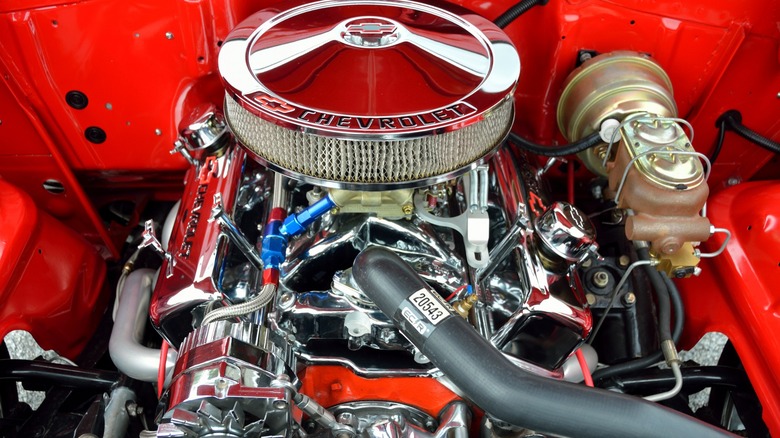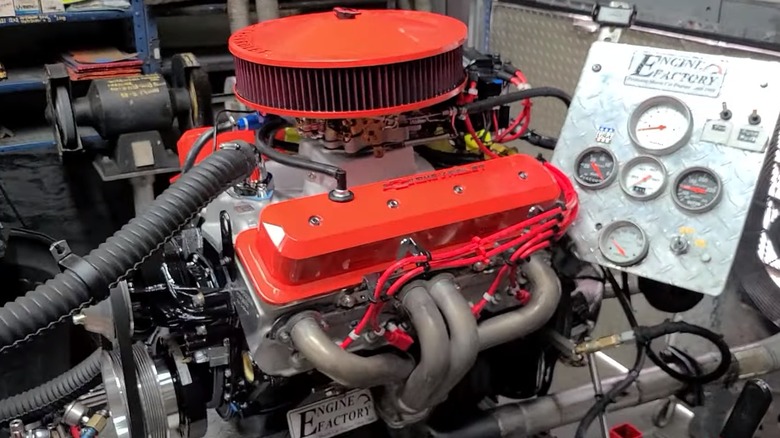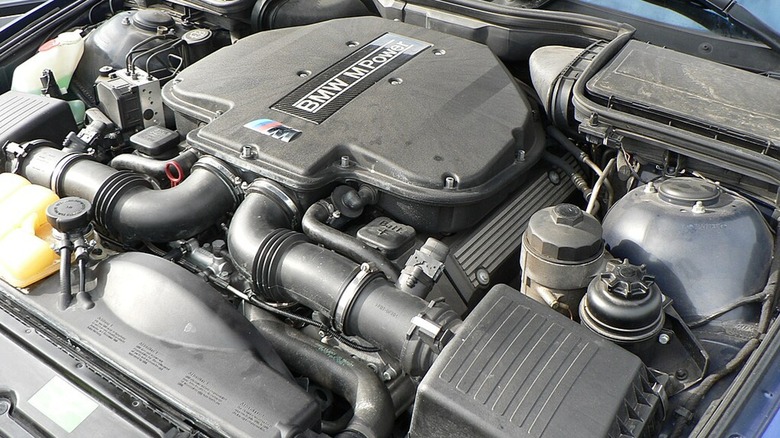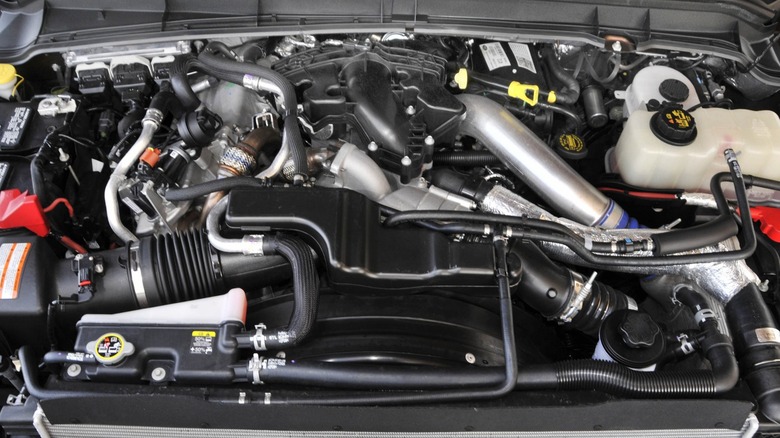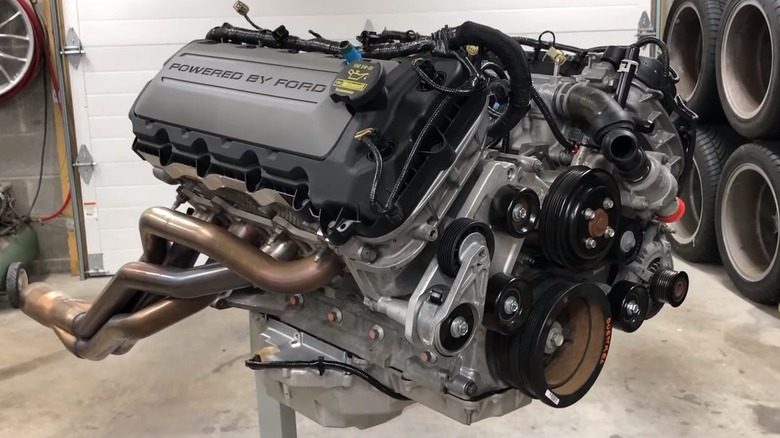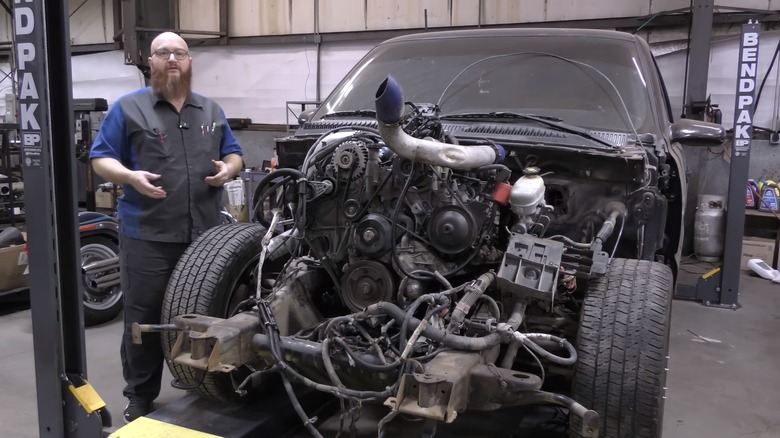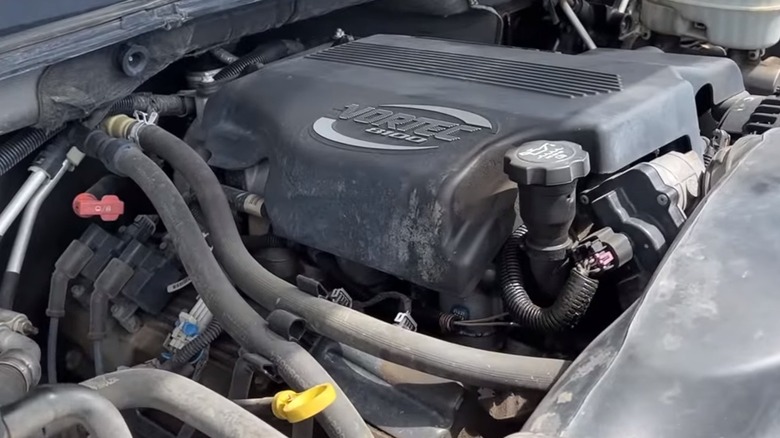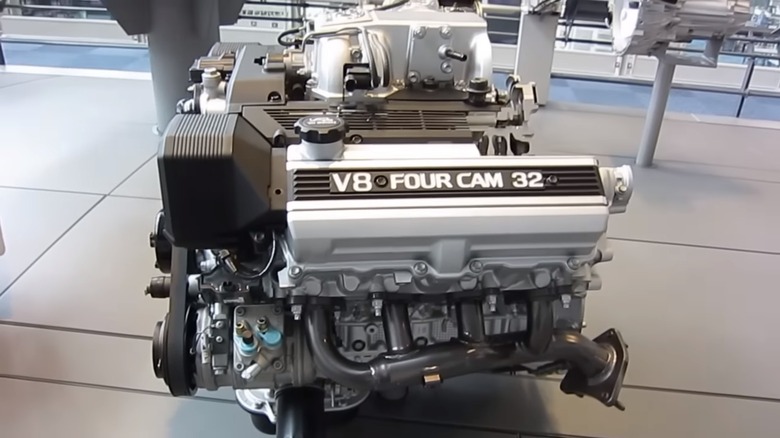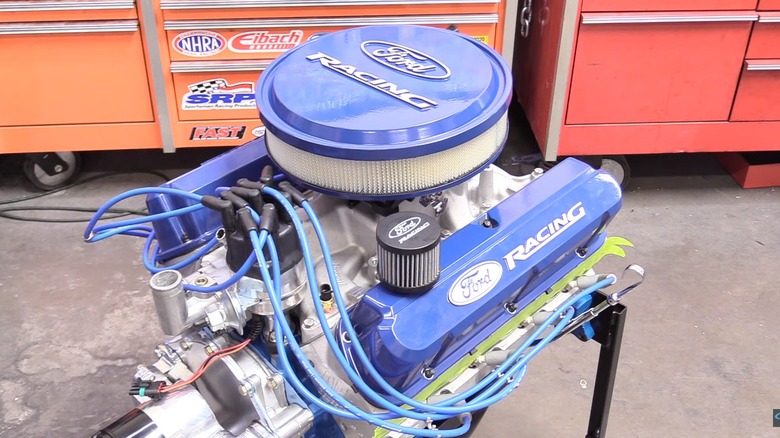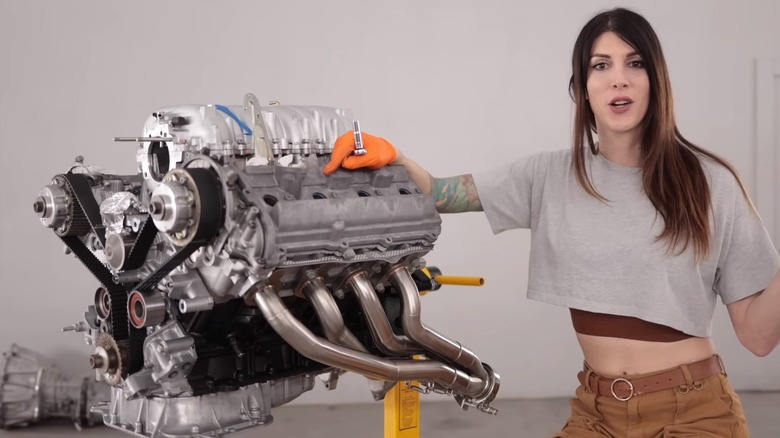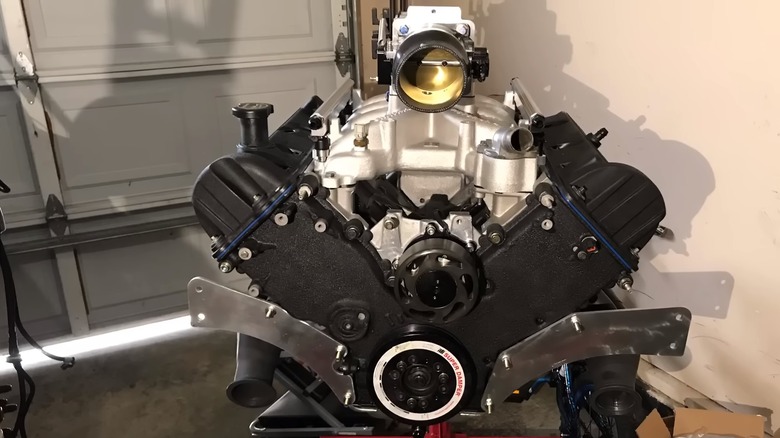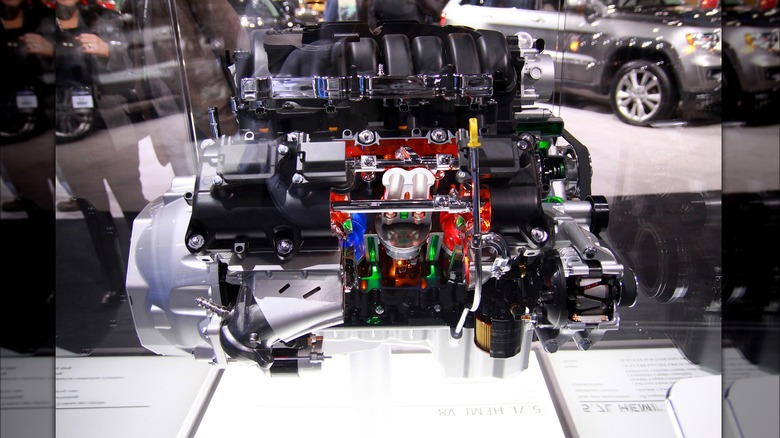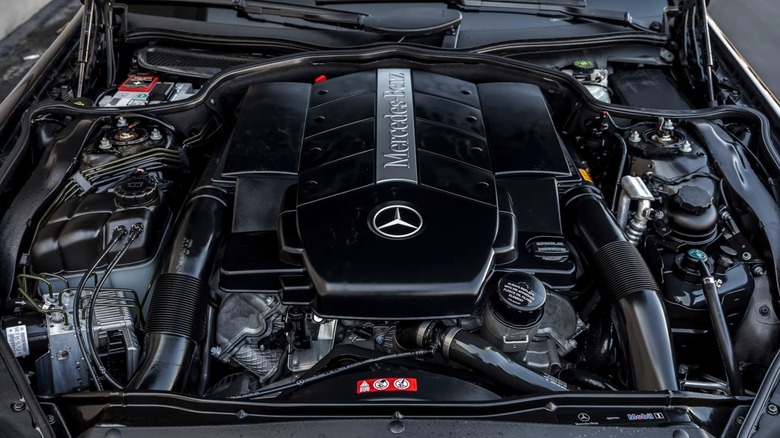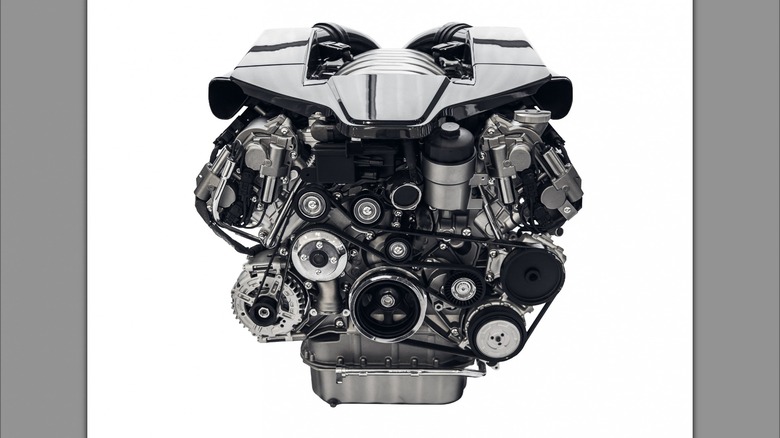12 Of The Most Reliable V8 Engines Ever Made
Of the many existing engine configurations, few hold the history, reverence, and flexibility of the mighty V8. It has been around for well over a century and is found in cars, trucks, buses, and everything in between. Furthermore, while a V8 can be found in an amazing and exceedingly expensive hypercar like a 1,280-horsepower Koenigsegg Jesko, it can also power more ordinary cars, such as the Ford Crown Victoria.
Automakers choose V8 engines for a variety of reasons. They naturally run smoother with less vibration than a V6 or 4-cylinder and have a higher ceiling for power output. V12 engines can also produce high power but at the cost of increased complexity. Moreover, a V8 engine is relatively compact and able to fit in a wide range of vehicle applications. However, the reliability of a V8 relates directly to its manufacturing, and nothing about the V8 configuration itself guarantees a trouble-free machine. Furthermore, what constitutes reliability varies wildly. Does it require less maintenance? Will it continue running on one quart of oil? Does it break down the least? These are all valid questions, but how about which one can go for the most miles without rebuilding? That signifies long-term durability, and a durable engine is a reliable one. We searched with the final question in mind and found various examples indicating these to be the most reliable V8 engines, in no particular order, based on the most miles driven without requiring an overhaul.
Chevrolet Small Block 350 -- 1.3 million miles
A new overhead-valve V8 engine from Chevrolet debuted in 1955 with a 265-cubic-inch displacement and went on to power millions of cars and trucks, largely unchanged, until the mid-1990s. It became widely known as the Small Block Chevrolet. At the core of its development was simplicity with low-cost production. The new engine combined efficient manufacturing with a simple design, using the fewest parts to result in a compact and lightweight engine that would prove to be robust and reliable. Displacements ranged from 265 to 400 cubic inches throughout production, and the Small Block has been a favorite of racers and hot rodders for generations. Because of its simple design, it is cheap and easy to repair, but when well maintained, that is not often necessary. Furthermore, it has powered millions of vehicles, including everything from Corvettes and Camaros to pickups and station wagons.
As a testament to the reliability and long-term durability of a Small Block Chevrolet, a gentleman from Catawba, Wisconsin, had a 1991 Chevrolet Silverado that surpassed one million miles. This happened in 2008 and made the news with reports coming from many prominent news outlets, including NPR. Although he had replaced the transmission, water pump, alternator, and power steering pump, the original engine was never cracked open for anything. He also kept a thorough and fastidious maintenance schedule. Four years later, he said in a phone interview that the miles had gone up to 1,289,882. This truck exemplifies just how long a Small Block Chevy can go, given diligent maintenance.
BMW S62 V8 -- 542,500 miles
Unless you are a bona fide BMW fanboy, you likely have some preconception that they are fussy and expensive German luxury cars that are unreliable and expensive to repair. Those things may be true, but the reliability factor may have more to do with poor maintenance, which can doom any car. Likewise, given proper maintenance, any car can exceed expectations. You may be surprised to hear about a BMW M5 with more than half a million miles.
The E39 BMW M5 was made from 1998 through 2004. Powering the car was a 5.0-liter V8 producing a naturally aspirated 400 horsepower. The S62 V8 engine is a highly technical engine developed using cutting-edge technology and sophisticated components to make it powerful yet refined. Potential weak spots include rod bearings, timing chains, and the VANOS variable valve timing system, all of which are very expensive to repair. However, they are also known to be strong and dependable when treated right, bucking the stereotype of German luxury sedans.
A 2002 model appeared on YouTube in 2022, showing an incredible 542,500 miles. Not only was it in excellent condition inside and out, but it was also claimed that the owner had never had the engine opened up for rebuild or repair and that it even had its original timing chain and guides. That is an impressive use of an M5, and though it may be the exception rather than the rule, it proves extra high mileage is possible from a complex BMW V8.
Ford Powerstroke 6.7-liter diesel -- 1.3 million miles
Built for Ford by Navistar, the Power Stroke heavy-duty diesel engine has proven to be a durable workhorse that has helped Ford's sales of heavy-duty trucks since 1994. Replacing its previous indirect injected engines with direct injection, the Power Stroke offered class-leading power with lower emissions.
The displacement of the Ford Power Stroke diesel was initially 7.3 liters. Ford reduced displacement to 6.0 liters in 2003 but raised it back up to 6.7 liters in 2011, which is what is found in current models. Some advancements in components and more emission-reducing equipment, such as diesel particulate filters, have been added, but the basics of the engine have remained constant. Power Strokes are well known for going many hundreds of thousands of miles, and at least a couple have cleared a million.
The first one featured in a recent YouTube video is owned by a gentleman who bought a new Super Duty with the 7.3-liter in 2000, and he claims to have cleared 1.3 million miles using the original engine and standard transmission as a hot-shot delivery driver. His records show that it hit a million miles back in 2012 and has been accruing more ever since. In another YouTube video, a 2013 F-350 with a 6.7-liter V8 had also accrued 1.3 million miles, and it did that in just eight years. Although it had a transmission replaced, the engine was all original but ran with a deleted EGR cooler and particulate filter. Regardless, for reliable longevity, the Power Stroke is hard to beat.
Ford 5.0-liter Coyote -- 326,000 miles
The development of the Ford Coyote V8 engine traces its roots back to 1991 when the first Modular Ford V8 engine came in the Lincoln Town Car. It was Ford's first mass-produced overhead-cam V8 engine, and it went on to be one of their most successful engines to date. Ford continued producing the 4.6-liter Modular engine through the '90s and '00s, increasing displacement and valve count, before ultimately replacing it in 2011 with a revised and upgraded version called Coyote.
Changes to the block gave it extra strength without increasing weight, but the biggest changes were in the heads. The new engine featured dual overhead cams with the game-changing Twin Independent Variable Cam Timing (Ti-VCT). This variable cam system provides dynamic control of valve timing, allowing engineers to use the ECU to manage fuel flow for incredible gains in power and efficiency.
While some may argue that complex modern engines don't have the longevity of earlier models, Ford Truck Enthusiasts interviewed a gentleman who bought a Coyote-powered 2012 F-150 in 2020 that already had 326,000 miles on it. After seeing it, he had thought it likely had about 60,000 on the odometer but was so impressed with the excellent condition of the truck, both physically and mechanically, that he bought it even after discovering the high mileage and had not experienced any problems by the time of the interview. Time will tell if it becomes another record holder, but it has already proven itself well.
Chevrolet 6.6-liter Duramax Turbodiesel V8 -- 1.2 million miles
In the late '90s, General Motors collaborated with its long-time partner, Isuzu, to develop a new diesel engine. The new DMAX Ltd. venture developed a 6.6-liter V8 called the Duramax, incorporating many advanced features now common on most trucks.
General Motors' introduction of this engine came at a time when it was under extreme pressure. Dodge had been selling its Cummins diesel trucks for a decade, and the Ford Power Stroke came in a few years later. GM's indirect injection V8 was coming up short. To remain competitive a better engine was necessary to compete, and the Duramax diesel came out well-positioned to get ahead. Its compact size, low weight, and advanced injection system made it the most powerful diesel engine in its segment upon introduction and helped to secure GM's place as a serious truck contender.
Though some of them are known to have had problems with the injectors, the Duramax is generally considered to be very reliable. Diesel Tech reported a couple who did work hauling trailers and campers long distances all over Canada and the U.S. using a 2006 Chevrolet Silverado 3500 HD powered by the Duramax diesel V8. In less than ten years of ownership, it had accumulated 1.2 million miles. By changing its oil often and keeping up with every other maintenance item, they managed to do a lot of long hauls relatively trouble-free, thanks to their Duramax.
Chevrolet 8.1-liter Vortec V8 -- 500,000 miles
Chevrolet re-engineered its line of V8 engines in the 1990s in an effort to update the technology and raise efficiency while lowering emissions. Furthermore, while its engines had been fuel-injected since the '80s, they used an inadequate throttle body fuel injection system instead of a much more efficient port fuel injection system. The Vortec 8100 lasted until 2001, ending decades of Chevy 454 production.
With its substantial 8.1 liters of displacement, the Vortec engine provides 340 horsepower and, more importantly, a significant 455 lb-ft of torque. The Drive caught wind of one that had provided a considerable amount of work even though the truck in which it sat looked a little worse for wear. Though it is not mentioned where it is located, a 2001 Chevy Silverado 3500 is still hauling loads for the owner of a salvage yard more than two decades after it left the factory. The pickup came with the 8.1-liter Vortec and is backed up by a manual transmission sending power to a single pair of wheels in the rear. The owner says that it has hauled up to 35,000 pounds of cargo while cruising at 70 mph with zero trouble.
You might think nothing of a Chevy 3500 pulling big loads, but this one looks rough. It is beat up on every panel and looks like it's held together by baling wire and hope. Yet, with more than 500,000 miles on the odometer, it continues to work, turning trash into treasure.
Toyota 1UZ-FE V8 -- 1 million miles
Toyota vehicles are legendary for reliability of the highest order. Not only is the company known for this, it prides itself on it. But when Toyota chose to enter the luxury car market back in the '80s, it left nothing to chance in creating what some consider the best V8 engine ever made, the Toyota 1UZ-FE.
Toyota began its push into the luxury market in 1983 with plans to create a new full-size sedan competitive with the best European sedans of the day. Knowing it would require a monumental effort to unseat the Europeans, Toyota spared no expense, spending $1 billion in 1980s money on the project. Particular attention was paid to the 4.0-liter V8 engine that would be found under the hood of the new luxury flagship. Nearly 4,000 people contributed to the development, and they built 900 prototypes before commencing production.
The car that received this engine, the Lexus LS400, set new standards for quality and reliability in the luxury market. While the styling may have been unadventurous, the driving experience was sublime. That is what makes it as good a car as any to spend time in while clearing the one-million-mile mark, just as auto journalist Matt Farah's LS400 did. He bought a 1996 model with an already impressive 897,000 miles in 2014, documenting and publicizing the last stretch to a million miles through various press outlets. Farrah's car crossed the threshold in 2019 without the engine being cracked open once.
Ford 5.0-liter Windsor -- 1.3 million miles
Around four decades worth of passenger cars and light trucks from the Ford Motor Company rolled out of the factories powered by what was essentially the same 302-cubic-inch Windsor V8 engine. Although some technical aspects would change, and a variety of updated components came attached to the block over the years, the block remained largely unchanged, with heads adapted through the years. Millions of Fords came with badges signifying the presence of a 302 V8 until 1977, with 5.0 replacing it afterward.
With the 5.0 Ford V8, the Mustang emerged in the '80s as a modern pony car, separating itself from its lowly and lethargic Mustang II predecessor and its serious lack of power. Initially, output increases were marginal, but the addition of multi-port fuel injection in the 5.0 H.O. engines made Ford automobiles competitive once again. While this engine was certainly a highlight of Ford's high-performance model, it was also found across its range of vehicles for years. The 5.0 engine was a staple for F-150 pickups, LTD Crown Victoria sedans, and Lincoln luxury vehicles.
Sometime at least 15 years ago, CNN interviewed and reported on a man in Topeka, Kansas, who drove a 1983 Lincoln Town Car. The Town Car in that year received the 5.0 Winsor engine with fuel injection, although it is a throttle body system good for only 130 horsepower. Regardless, the Town Car is built for comfort and would have been a fine place to drive a leisurely 1.3 million miles as this man did in his.
Toyota 2UZ-FE V8 -- 1 million miles
Toyota scored a huge win with its first mass-produced V8 for the 1989 Lexus LS400. However, to expand into the full-size truck market of North America, an engine designed for torque was needed. Building upon the excellent engineering of the first V8, Toyota began production of the new 2UZ-FE in 1998.
The new engine shares many attributes with the 1UZ but opted for a larger displacement of 4.7 liters and a cast-iron block instead of aluminum. With the dominance of the Big Three of Detroit, Toyota had an uphill climb to establish itself in the market. Reviewers from The New York Times and Car and Driver walked away impressed with the debut model, and Tundras have gained loyal fans ever since.
Anyone familiar with the Tundra should not be surprised to hear that its V8 engine is a reliable one. A few years back, Toyota swapped a brand-new Tundra for one that a customer had driven a million miles. Eager to see its condition after so much use, Toyota quality control removed the engine for a thorough evaluation. First, a run on the dynamometer showed its power output to be about the same as when it was new. Then, they tore it down for a close inspection. The results were excellent and would have garnered a 99/100 on one of their routine quality tests. That this V8 can run for so long and end up no worse for wear is a testament to the build quality of a Toyota V8.
Ford Modular 4.6-liter V8 -- 1 million miles
In 1991, the Lincoln Continental was an engine that represented a significant departure for an American-produced V8 engine. The engine that would eventually replace the long-lived 302 and 351 was the first regular production American V8 with overhead cams. The first variant displaced 4.6 liters, with a single cam on each head working two valves per cylinder. Its output of 190 horsepower was modest, especially by today's standards, but it represented an increase of 40 horsepower over its pushrod-based predecessor.
The Modular V8 expanded throughout the Ford lineup, eventually becoming the standard V8 on cars and trucks by the early 2000s. The 4.6-liter version powered Mustangs, Crown Victorias, and F-150s, while a 5.4-liter version later became available for trucks. When Ford developed this engine, it was looking for ways to increase efficiency while boosting power on a platform that would work with a low-stress load.
With the ample miles seen on vehicles like work trucks and taxis, plenty of Modular-driven Fords have high mileage. A video from 2013 by Schaeffer Oil shows the teardown of a 5.4-liter Modular V8 from a van used for security patrols with over a million miles on it. It had been well maintained using Schaeffer Oil products, and the internal parts came out looking extraordinarily clean with little wear. They credit the use of Schaeffer products for the engine's exceptional condition, but without a good foundation from Ford's quality manufacturing, it could not have gone that many miles in the first place.
Chrysler 5.7-liter Hemi V8 -- 500,000 miles
Well before the muscle car era, when American automotive legends such as the Hemi Charger, Challenger, and Super Bee were tearing up the streets, Chrysler produced its first Hemi. Hemis became major players through the '60s, powering some of the fastest street and race cars until things started to wind down in the 1970s and Hemi production ended. A rebirth occurred in 2003 when Chrysler released a new crop of modern Hemi engines and reignited Chrysler's penchant for high-powered engines once again.
While the new Hemi V8 engines made headlines in the automotive press for the new surge of power coming in Challengers and Chargers, Dodge also offered Hemi engine options in its Ram trucks. According to a post from AllPar.com, in 2004, a Texas business owner looking for a new truck picked up a Ram 1500 with one of the recently released 5.7-liter Hemi engines. As the business owner of an aircraft maintenance company, Jubel Caldwell needed a dependable truck for regular runs to Fort Worth and jobs on location all over the area. He probably had no idea how dependable the truck would turn out to be as he surpassed 500,000 miles in less than 10 years of ownership. Aside from a dropped valve at 115,000 miles and a transmission rebuild at 486,000 miles, he claims the truck had no significant issues.
Mercedes-Benz 5.4-liter M113K V8 -- 400,000 miles
While Mercedes-Benz vehicles are known for often being troublesome cars made with extreme sophistication and costly parts, they are also known to have built cars in the past that are incredibly durable and long-lasting. Mercedes is so proud of this fact that in the 1960s, it established a high-mileage award for owners who have taken their cars a bit further than most, and the current record holder is a Greek taxi driver who drove his 240D 2.8 million miles. However, the 240D is not a V8 vehicle.
It has been a while since this video debuted, but the YouTube channel Legit Street Cars managed to pick up a 2003 Mercedes-Benz E55 AMG with 401,000 miles. It was a one-owner car with extensive records that survived in great condition inside and out. The supercharged 32-valve V8 engine, when new, was good for 469 horsepower and made the E55 one of the fastest cars around in its day. It had always been serviced by the same dealer and still drove like new as it approached half a million miles. Based on records related to the car, the cost to keep the car going up to 400,000 miles, including tires, amounted to about $50,000 over 11 years. It may have needed some expensive repairs along the way, but the engine remained all-original and continued to run like new, even with so many miles.
What makes an engine reliable?
As mentioned in the intro, various metrics can be used to determine reliability. While some of these can be easy to gather, others could be more subjective, such as user reviews posted online. Ultra-high mileage may not be the most useful or definitive metric to ascertain engine reliability, but it is useful to know how durable the main internal engine components can be. Regardless, this information is provided to be entertaining and informative but not authoritative; we sought the most credible sources of information possible to compile this list. Regardless, should you be researching vehicles for a potential purchase, remember to research vehicles thoroughly, gathering information from multiple sources.
